| |
- People -
There were many people involved in Project Apollo,
both on the ground and in space. Over the course of the missions leading
up to and after Apollo 11, several notable people worked to make the project
a success. This page documents their lives and their involvement with
the Apollo Project. For more information on each mission, please explore
the timeline.
Apollo 1 -
January 27, 1967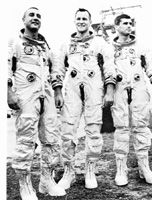
In the race to put a man on the moon, these three astronauts
were the first casualties. During a preflight test for Apollo 1, a fire
broke out on the launchpad and spread to the command module. All three
astronauts lost their lives, and NASA lost confidence in its program.
After extensive reworking of the system, and several unmanned flights,
NASA returned to manned spaceflight with Apollo 7 in 1968.
Crew Biography:
- Gus Grissom—Virgil I. (Gus) Grissom (1927-1967)
was chosen with the first group of astronauts in 1959. He was the
pilot for the 1961 Mercury-Redstone 4 (Liberty Bell 7) mission, a
suborbital flight; command pilot for Gemini 3; backup command pilot
for Gemini VI; and had been selected as commander of the first Apollo
flight at the time of his death in the Apollo 204 fire on 27 January
1967. Cumulative hours of spaceflight are more than 5.
- Ed White—WHITE, Edward H., II, Lieutenant
Colonel, U.S. Air Force. Born November 14, 1930, in San Antonio, Texas.
Bachelor of science from US Military Academy; master of science in
aeronautical engineering from University of Michigan. Flew on Gemini
IV. Cumulative hours of spaceflight are more than 97. Cumulative EVA
time is more than 23 minutes. Died January 27, 1967, at NASA John
F. Kennedy Space Center, Florida, in the Apollo spacecraft fire.
- Roger Chafee—CHAFFEE, Roger B.,
Lieutenant Commander, US Navy. Born February 15, 1935, in Grand Rapids,
Michigan. Bachelor of science in aeronautical engineering from Purdue
University. Died January 27, 1967, at NASA John F. Kennedy Space Center,
Florida, in the Apollo spacecraft fire.
Apollo 7 -
October 11-22, 1968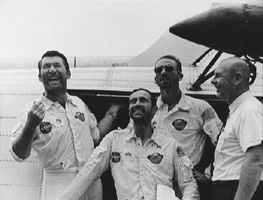
Crew Biography:
- Wally Schirra—SCHIRRA,
Walter M., Jr., Captain, US Navy (Retired). Born March 12, 1923, in
Hackensack, New Jersey. Bachelor of science from US Naval Academy;
graduate of US Naval Test Pilot School. Flew on Mercury 8, Gemini
VI, and Apollo 7. Cumulative hours of spaceflight are more than 295.
- Donn Eisele—EISELE, Donn F., Colonel,
US Air Force (Retired). Born June 23, 1930, in Columbus, Ohio. Bachelor
of science in astronautics from US Naval Academy; master of science
in astronautics from US Air Force Institute of Technology. Flew on
Apollo 7. Cumulative hours of spaceflight are more than 260. Died
December 2, 1987, in Tokyo, Japan, of a heart attack.
- Walter Cunningham—CUNNINGHAM, Walter,
Colonel, US Marine Corps Reserve (Retired) Born March 16, 1932, in
Creston, Iowa. Bachelor and master of arts in physics from University
of California at Los Angeles; Advanced Management Program, Harvard
Graduate School of Business. Flew on Apollo 7. Cumulative hours of
spaceflight are more than 263.
Apollo 8 -
December 21-27, 1968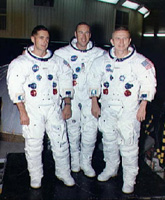
Crew Biography:
- Frank Borman—BORMAN, Frank, Colonel,
US Air Force (Retired) Born March 14, 1928, in Gary, Indiana. Bachelor
of science from US Military Academy; master of science in aeronautical
engineering from California Institute of Technology. Flew on Gemini
VII and Apollo 8. Cumulative hours of spaceflight are more than 477.
- Jim Lovell—LOVELL, James A., Jr.,
Captain, US Navy (Retired) Born March 25, 1928, in Cleveland, Ohio.
Bachelor of science from US Naval Academy; Advanced Management Program,
Harvard Graduate School of Business. Flew on Gemini VII, Gemini XII,
Apollo 8, and Apollo 13. Cumulative hours of spaceflight are more
than 715.
- Bill Anders—ANDERS, William A.,
Major General, US Air Force Reserve (Retired) Born October 17, 1933,
in Hong Kong. Bachelor of science in nuclear engineering from US Naval
Academy; master of science in nuclear engineering from Air Force Institute
of Technology. Flew on Apollo 8. Cumulative hours of spaceflight are
more than 147.
Apollo 9 - March 3-13,
1969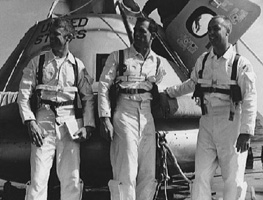
Crew Biography:
- Jim McDivitt—McDIVITT, James A., Brigadier
General, US Air Force (Retired) Born June 10, 1929, in Chicago, Illinois.
Bachelor of science in aeronautical engineering from University of
Michigan. Flew on Gemini IV and Apollo 9, and was the Apollo Spacecraft
Program Manager. Cumulative hours of spaceflight are more than 338.
- Dave Scott—SCOTT, David R., Colonel, US
Air Force (Retired) Born June 6, 1932, in San Antonio, Texas. Bachelor
of science from US Military Academy; master of science in aeronautics
and astronautics and engineer in aeronautics and astronautics from
Massachusetts Institute of Technology. Flew on Gemini VIII, Apollo
9, and Apollo 15. Cumulative hours of spaceflight are more than 546.
Cumulative EVA time is more than 20 hours.
- Russell R. Schweikart
Apollo 10 -
May 18-26, 1969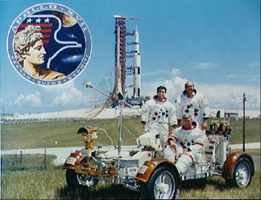
Crew Biography:
- Tom Stafford—STAFFORD,
Thomas P., Lieutenant General, US Air Force (Retired) Born September
17, 1930, in Weatherford, Oklahoma. Bachelor of science from US Naval
Academy. Flew on Gemini VI, Gemini IX, Apollo 10, and Apollo-Soyuz
Test Project. Cumulative hours of spaceflight are more than 507.
- John Young—YOUNG, John W., Captain, US Navy
(Retired) Pilot Born September 24, 1930, in San Francisco, California.
Bachelor of science in aeronautical engineering from Georgia Institute
of Technology. Flew on Gemini 3, Gemini X, Apollo 10, Apollo 16, STS-1,
and STS-9. Cumulative hours of spaceflight are more than 835. Cumulative
EVA time is more than 20 hours (on the Moon).
- Gene Cernan—CERNAN, Eugene A., Captain,
US Navy (Retired) Born March 14, 1934, in Chicago, Illinois. Bachelor
of science in electrical engineering from Purdue University; master
of science in aeronautical engineering from US Navy Postgraduate School.
Flew on Gemini IX, Apollo 10, and Apollo 17. Cumulative hours of spaceflight
are more than 566. Cumulative EVA time is more than 73 hours.
Apollo 11 -
July 16-24, 1969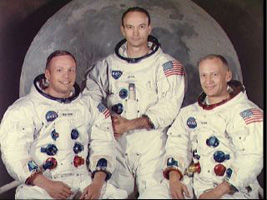
For more information on Apollo 11
and the moon landing, please explore the Eagle
page.
Crew Biography (detailed):
- Neil Armstrong
- Neil Alden Armstrong (1930- ) was born on 5 August 1930 on his grandparents'
farm near Wapakoneta, Ohio, to Stephen and Viola Armstrong. Because
Armstrong's father was an auditor for the State of Ohio, Armstrong
grew up in several communities, including Warren, Jefferson, Ravenna,
St. Marys, and Upper Sandusky, before the family settled in Wapakoneta.
Armstrong developed an interest in flying at only
age two when his father took him to the National Air Races in Cleveland,
Ohio. His interest intensified when he went for his first airplane
ride in a Ford Tri-Motor, a "Tin Goose," in Warren, Ohio,
at age six. From that time on, he claimed an intense fascination
with aviation.
At age fifteen, Armstrong began taking flying lessons
at an airport north of Wapakoneta, working at various jobs in town
and at the airport to earn the money for lessons in an Aeronca Champion
airplane. By age sixteen, he had his student pilot's license, before
he even passed his automobile driver's test and received that license
and before he graduated from Blume High School in Wapakoneta in
1947.
Immediately after high school Armstrong received
a scholarship from the US Navy. He enrolled at Purdue University
and began his studies of aeronautical engineering. In 1949, the
Navy called him to active duty, where he became an aviator, and
in 1950, he was sent to Korea. There he flew seventy-eight combat
missions from the aircraft carrier U.S.S. Essex.
After mustering out of the Navy in 1952, Armstrong
joined the National Advisory Committee for Aeronautics (NACA). His
first assignment was at the NACA's Lewis Research Center, near Cleveland,
Ohio. Lewis Flight Propulsion Laboratory (later NASA's Lewis Research
Center, Cleveland, Ohio, and today the Glenn Research Center) in
1955. For the next seventeen years, he was an engineer, test pilot,
astronaut, and administrator for the NACA and its successor agency,
the National Aeronautics and Space Administration (NASA).
In the mid-1950s Armstrong transferred to NASA's
Flight Research Center, Edwards, California, where he became a research
pilot NACA's High-Speed Flight Station (today, NASA's Dryden Flight
Research Center) at Edwards Air Force Base in California as an aeronautical
research scientist and then as a pilot on many pioneering high-speed
aircraft, including the well-known, 4,000-mph X-15. He flew over
200 different models of aircraft, including jets, rockets, helicopters,
and gliders. While there he also pursued graduate studies, and received
a master of science degree in aerospace engineering from the University
of Southern California.
Armstrong transferred to astronaut status in 1962,
one of nine NASA astronauts in the second class to be chosen. He
moved to El Lago, Texas, near Houston's Manned Spacecraft Center,
to begin his astronaut training. There he underwent four years of
intensive training for the Apollo program to land an American on
the Moon before the end of the decade.
On 16 March 1966, Armstrong flew his first space
mission as command pilot of Gemini VIII with David Scott. During
that mission Armstrong piloted the Gemini VIII spacecraft to a successful
docking with an Agena target spacecraft already in orbit. While
the docking went smoothly and the two craft orbited together, they
began to pitch and roll wildly. Armstrong was able to undock the
Gemini and used the retro rockets to regain control of his craft,
but the astronauts had to make an emergency landing in the Pacific
Ocean.
As spacecraft commander for Apollo 11, the first
piloted lunar landing mission, Armstrong gained the distinction
of being the first person to step on the surface of the Moon. On
16 July 1969, Armstrong, Michael Collins, and Edwin E. "Buzz"
Aldrin began their trip to the Moon. Collins was the Command Module
pilot and navigator for the mission. Aldrin, a systems expert, was
the Lunar Module pilot and became the second person to walk on the
Moon. As commander of Apollo 11, Armstrong piloted
the Lunar Module to a safe landing on the Moon's surface. On 20
July 1969, at 10:56 p.m. EDT, Neil Armstrong stepped down onto the
Moon and made his famous statement, "That's one small step
for a man, one giant leap for mankind." Armstrong and Aldrin
spent about two and one-half hours walking on the Moon collecting
samples, doing experiments, and taking photographs. On 24 July 1969,
the three men splashed down in the Pacific Ocean. They were picked
up by the aircraft carrier, U.S.S. Hornet.
The three Apollo 11 astronauts were honored with
a ticker tape parade in New York City soon after returning to Earth.
Armstrong received the Medal of Freedom, the highest award offered
to a US civilian. Armstrong's other awards coming in the wake of
the Apollo 11 mission included the NASA Distinguished Service Medal,
the NASA Exceptional Service Medal, seventeen medals from other
countries, and the Congressional Space Medal of Honor.
Armstrong subsequently held the position of Deputy
Associate Administrator for Aeronautics, NASA Headquarters, Washington,
D.C., in the early 1970s. In that position, he was responsible for
the coordination and management of overall NASA research and technology
work related to aeronautics.
After resigning from NASA in 1971, he became a professor
of Aerospace Engineering at the University of Cincinnati from 1971
to 1979. During the years 1982-1992, Armstrong served as chairman
of Computing Technologies for Aviation, Inc., in Charlottesville,
Virginia. He then became chairman of the board of AIL Systems, Inc.,
an electronics systems company in Deer Park, New York. At the present
time, Armstrong lives on his farm in Lebanon, Ohio.
- Michael Collins—Michael Collins
(1930- ) was born on October 30, 1930, in Rome, Italy. He later moved
to Washington, DC, where he graduated from St. Albans School. In 1952,
he attended the US Military Academy at West Point, New York, and received
his bachelor of science degree.
Prior to joining NASA, Collins served as a fighter
pilot and an experimental test pilot at the Air Force Flight Center,
Edwards Air Force Base, California. From 1959 to1963 he logged more
than 4,200 hours of flying time.
In October 1963, Michael Collins became one of the
third group of astronauts named by NASA. He served as a pilot on
the three-day Gemini X mission, launched July 18, 1966. During this
mission, he set a world altitude record and became the nation’s
third spacewalker while completing two extravehicular activities
(EVA).
His second flight was as Command Module pilot of
the historic Apollo 11 mission in July 1969. He remained in lunar
orbit while Neil Armstrong and Buzz Aldrin became the first people
to walk on the Moon. His role in the Apollo mission earned him many
awards and accolades, including the Presidential Medal for Freedom
in 1969.
In January 1970, Collins left NASA to become the
Assistant Secretary of State for Public Affairs. A year later he
joined the Smithsonian Institution as the Director of the National
Air and Space Museum, where he remained for seven years. While in
this position, he was responsible for the construction of the new
museum building, which opened to the public in July 1976, ahead
of schedule and below its budgeted cost. In April 1978, Collins
became Under Secretary of the Smithsonian Institution.
In 1980, he became the Vice President of the LTV
Aerospace and Defense Company, resigning in 1985 to start his own
firm.
Collins has completed two spaceflights, logging
266 hours in space, of which 1 hour and 27 minutes was spent in
EVA. He has written about his experiences in the space program in
several books, including Carrying the Fire and Flying to the Moon
and other Strange Places. In 1988, he wrote Liftoff: the Story of
America’s Adventure in Space. Today he is an aerospace consultant
and writer.
- Buzz Aldrin—Edwin E. Aldrin, Jr.
(1930- ) was born in Montclair, New Jersey, on 20 January 1930. He
attended the US Military Academy at West Point, entered the United
States Air Force, and received pilot training in 1951. Aldrin flew
sixty-six combat missions in F-86s in Korea, destroying two MIG-15
aircraft. Known to all as by his nickname, "Buzz," Aldrin
was also one of the most important figures in the accomplishment of
Project Apollo in successfully landing an American on the Moon in
1960s.
Aldrin became an astronaut during the selection
of the third group by NASA in October 1963. On 11 November 1966
he orbited aboard the Gemini XII spacecraft, a 4-day 59-revolution
flight that successfully ended the Gemini program. It proved to
be a fortuitous selection, for during Project Gemini Aldrin became
one of the key figures working on the problem of rendezvous of spacecraft
in Earth or lunar orbit, and docking them together for spaceflight.
Without these skills Apollo could not have been successfully completed.
Aldin, with a Ph.D. in astronautics from Massachusetts Institute
of Technology, was ideally qualified for this work, and his intellectual
inclinations ensured that he carried out these tasks with enthusiasm.
Systematically and laboriously, Aldrin worked to develop procedures
and tools necessary to accomplish space rendezvous and docking.
He was also a central figure in devising the methods necessary to
carry out extravehicular activities (EVA) of astronauts outside
their vehicles. That, too, was critical to the successful accomplishment
of Apollo.
Aldrin was chosen as a member of the three-person
Apollo 11 crew that landed on the Moon on 20 July 1969, fulfilling
the mandate of President John F. Kennedy to send Americans to the
Moon before the end of the decade. Aldrin was the second American
to set foot on the lunar surface. He and Apollo 11 commander Neil
A. Armstrong spent about twenty hours on the Moon before returning
to the orbiting Apollo Command Module. The spacecraft and the lunar
explorers returned to Earth on 24 July 1969.
In 1971 Aldrin returned to the Air Force and
retired a year later. He wrote two important books about his activities
in the US space program. In Return to Earth (1970), Aldrin recounted
the flight of Apollo 11. In the more broadly constructed Men from
Earth (1989), Aldrin discussed the entire space race between the
United States and the Soviet Union. He has been an important analyst
of the space program since the 1960s. He lives near Los Angeles,
California.
Apollo 12 -
November 14-24, 1969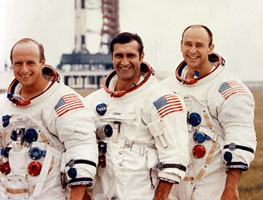
Crew Biography:
- Pete Conrad—CONRAD, Charles, Jr., Captain, US
Navy (Retired) Born June 2, 1930, in Philadelphia, Pennsylvania. Bachelor
of science in aeronautical engineering from Princeton University.
Flew on Gemini V, Gemini XI, Apollo 12, and Skylab 2. Cumulative hours
of spaceflight are more than 1,179. Cumulative EVA time is more than
14 hours.
- Richard Gordon—GORDON, Richard F., Jr., Captain,
US Navy (Retired) Born October 5, 1929, in Seattle, Washington. Bachelor
of science in chemistry from University of Washington; honorary doctorate
of science from Niagara University. Flew on Gemini XI and Apollo 12.
Cumulative hours of spaceflight are more than 315. Cumulative EVA
time is more than 1 hour.
- Alan Bean—BEAN, Alan L., Captain, US Navy (Retired)
Born March 15, 1932, in Wheeler, Texas. Bachelor of science in aeronautical
engineering from University of Texas. Flew on Apollo 12 and Skylab
3. Cumulative hours of spaceflight are more than 1,671. Cumulative
EVA time is more than 10 hours.
Apollo 13 -
April 11-17, 1970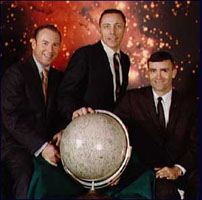
Crew Biography:
- Jim Lovell—LOVELL, James A., Jr., Captain, US
Navy (Retired) Born March 25, 1928, in Cleveland, Ohio. Bachelor of
science from US Naval Academy; Advanced Management Program, Harvard
Graduate School of Business. Flew on Gemini VII, Gemini XII, Apollo
8, and Apollo 13. Cumulative hours of spaceflight
are more than 715.
- Fred Haise—HAISE, Fred W., Jr., Civilian Born
November 14, 1933, in Biloxi, Mississippi Bachelor of science in aeronautical
engineering from University of Oklahoma. Flew on Apollo 13 and Space
Shuttle approach and landing tests 1, 3,and 5. Cumulative hours of
spaceflight are more than 142.
- Jack Swigert—SWIGERT, John L., Jr., Civilian
Born August 30, 1931, in Denver, Colorado. Bachelor of science in
mechanical engineering from University of Colorado; master of science
in aerospace science from Rensselaer Polytechnic Institute; master
of business administration from Hartford College. Flew on Apollo 13.
Cumulative hours of spaceflight are more than 142. Died December 27,
1982.
Apollo 14 -
January 31-February 9, 1971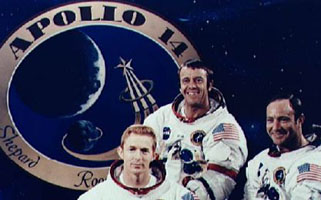
Crew Biography:
- Alan Shepard—Alan B. Shepard, Jr. (1923-1998)
was born November 18, 1923, in East Derry, New Hampshire. He received
a bachelor of science degree from the US Naval Academy. Shepard was
a member of the first group of seven astronauts in 1959 chosen to
participate in Project Mercury. He became the first
American in space, with a suborbital flight aboard his Freedom 7 Mercury
spacecraft on 5 May 1961. He also commanded Apollo 14 in 1971, when
he landed on the Moon. His cumulative hours of spaceflight are more
than 216 and cumulative EVA time is more than 9 hours.
- Stuart Roosa—ROOSA, Stuart A., Colonel, US Air
Force (Retired) Born August 16, 1933, in Durango, Colorado. Bachelor
of science in aeronautical engineering from University of Colorado.
Flew on Apollo 14. Cumulative hours of spaceflight are more than 216.
Died December 12, 1994.
- Edgar Mitchell—MITCHELL, Edgar D., Captain,
US Navy (Retired) Born September 17, 1930, in Hereford, Texas. Bachelor
of science in industrial management from Carnegie Institute of Technology
(now Carnegie-Mellon University); bachelor of science in aeronautical
engineering from US Naval Postgraduate School; doctorate of science
in aeronautics and astronautics from Massachusetts Institute of Technology.
Flew on Apollo 14. Cumulative hours of spaceflight are more than 216.
Cumulative EVA time is more than 9 hours.
Apollo 15 -
July 26-August 7, 1971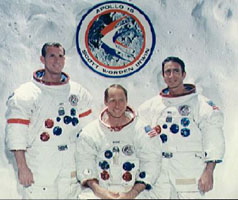
Crew Biography:
- Dave Scott—SCOTT, David R., Colonel, US Air Force
(Retired) Born June 6, 1932, in San Antonio, Texas. Bachelor of science
from US Military Academy; master of science in
aeronautics and astronautics and engineer in aeronautics and astronautics
from Massachusetts Institute of Technology. Flew on Gemini VIII, Apollo
9, and Apollo 15. Cumulative hours of spaceflight are more than 546.
Cumulative EVA time is more than 20 hours.
- Jim Irwin—IRWIN, James B., Colonel, US Air Force
(Retired) Born March 17, 1930, in Pittsburgh, Pennsylvania. Bachelor
of science in naval science from US Naval Academy; master of science
in aeronautical engineering and instrumentation engineering from University
of Michigan. Flew on Apollo 15. Cumulative hours of spaceflight are
more than 295. Cumulative EVA time is more than 18 hours. Died August
8, 1991, of a heart attack.
- Al Worden—WORDEN, Alfred M., Colonel, US
Air Force (Retired) Born February 7, 1932, in Jackson, Michigan. Bachelor
of science in military science from US Military Academy; master of science
in astronautical and aeronautical engineering and instrumentation engineering
from University of Michigan. Flew on Apollo 15. Cumulative hours of
spaceflight are more than 295. Cumulative EVA time is more than 39 minutes.
Apollo 16 -
April 16-27, 1972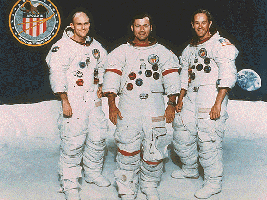
Crew Biography:
- John Young—YOUNG, John W., Captain, US Navy (Retired)
Pilot Born September 24, 1930, in San Francisco, California. Bachelor
of science in aeronautical engineering from Georgia Institute of Technology.
Flew on Gemini 3, Gemini X, Apollo 10, Apollo 16, STS-1, and STS-9.
Cumulative hours of spaceflight are more than 835.
Cumulative EVA time is more than 20 hours (on the Moon).
- T.K. Mattingly—MATTINGLY, Thomas K., II, Rear
Admiral, US Navy. Born March 17, 1936, in Chicago, Illinois. Bachelor
of science in aeronautical engineering from Auburn University. Flew
on Apollo 16, STS-4, and STS 51-C. Cumulative hours of spaceflight are
more than 508. Cumulative EVA time is more than 1 hour.
-
Charlie Duke—DUKE, Charles M., Jr., Brigadier
General, US Air Force (Retired) Born October 3, 1935, in Charlotte,
North Carolina. Bachelor of science in naval sciences from US Naval
Academy; master of science in aeronautics from Massachusetts Institute
of Technology. Flew on Apollo 16. Cumulative hours of spaceflight
are more than 265. Cumulative EVA time is more than 20 hours.
Apollo 17 -
December 7-19, 1972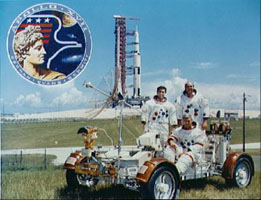
Crew Biography:
- Gene Cernan—CERNAN, Eugene A., Captain, US Navy
(Retired) Born March 14, 1934, in Chicago, Illinois. Bachelor of science
in electrical engineering from Purdue University;
master of science in aeronautical engineering from US Navy Postgraduate
School. Flew on Gemini IX, Apollo 10, and Apollo 17. Cumulative hours
of spaceflight are more than 566. Cumulative EVA time is more than 73
hours.
- Ron Evans—EVANS, Ronald E., Captain, U.S. Navy
(Retired) Born November 10, 1933, in St. Francis, Kansas. Bachelor of
science in electrical engineering from University of Kansas; master
of science in aeronautical engineering from U.S. Naval Postgraduate
School. Flew on Apollo 17. Cumulative hours of spaceflight are more
than 301. Cumulative EVA time is more than 1 hour. Died April 6, 1990,
in Scottsdale, Arizona, of a heart attack.
- Harrison Schmitt—SCHMITT, Harrison H., Civilian
Born July 3, 1935, in Santa Rita, New Mexico. Bachelor of science in
geology from California Institute of Technology; doctorate of philosophy
in geology from Harvard University. Flew on Apollo 17. Cumulative hours
of spaceflight are more than 301. Cumulative EVA time is more than 22
hours.
|
|